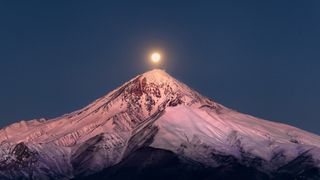How to see February's Snow Moon this week
Don't miss a rare appearance of Mercury and the full moon this week.

This week, you can lunch with the Snow Moon, which will appear at its fullest at 11:57 a.m. EST (1657 GMT) on Wednesday, Feb. 16.
If you can't make this lunar lunch date, the moon will still be a perfect companion for other outdoor activities, appearing full for three days, from Tuesday (Feb. 15) through Thursday night (Feb. 17), according to NASA.
If you see a bright star near the full moon, that's Regulus, the brightest star in the constellation Leo (the lion) and a harbinger of spring in the Northern Hemisphere, according to NASA and EarthSky.
Related: Dazzling photos of the solar eclipse from Antarctica
During the full moon, the moon, Earth and the sun line up, in that order, on an imaginary 180-degree line. The sun's rays illuminate the side of the moon facing Earth because the moon's orbit is about 5 degrees off of Earth's, usually putting it slightly above or below Earth's shadow. In other words, the moon plays peekaboo with the sun, popping out fully illuminated nearly every month (and sometimes more than once a month).
February's full moon has several names, including the Snow Moon and the Storm Moon, due to the heavy snowfall in many places this time of year, according to the Maine Farmers' Almanac, which published Native American moon names in the 1930s, NASA reported. Snowy weather and storms made hunting challenging, so the Hunger Moon was another historical Native American name for February's moon.
Old European names for this moon include the Candles Moon, which is tied to the Feb. 2 Christian festival Candlemas, which marks when Mary presented her son Jesus to God as her firstborn, according to Britannica.
Sign up for the Live Science daily newsletter now
Get the world’s most fascinating discoveries delivered straight to your inbox.
Besides the full moon, skygazers can catch some other celestial wonders this week. Normally, the solar system's innermost planet, Mercury, is visible only at sunrise or sunset. But at 3:59 p.m. EST (2059 GMT) on Wednesday, people with a large enough telescope will be able to see a half-lit Mercury. This glimpse of the smallest planet is possible because, about six times a year, Mercury swings out to one side of the sun from Earth's perspective, according to EarthSky. When Mercury is farthest from the sun, it is at its "greatest elongation."
Whether you're spotting the Snow Moon, Regulus or Mercury, be glad that winter is more than halfway through. At 88.99 days, winter is the shortest season; the spring equinox is on March 20, 2022.
Originally published on Live Science.

Laura is the archaeology and Life's Little Mysteries editor at Live Science. She also reports on general science, including paleontology. Her work has appeared in The New York Times, Scholastic, Popular Science and Spectrum, a site on autism research. She has won multiple awards from the Society of Professional Journalists and the Washington Newspaper Publishers Association for her reporting at a weekly newspaper near Seattle. Laura holds a bachelor's degree in English literature and psychology from Washington University in St. Louis and a master's degree in science writing from NYU.
Most Popular

